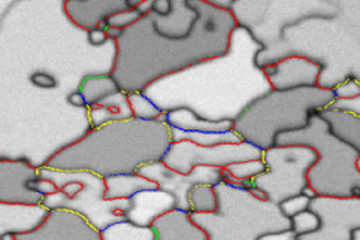All genres
761.
Talk
Ab initio simulations of point defects put to the melting temperature. DPG-Frühjahrstagung 2013, Regensburg, Germany (2013)
762.
Talk
Fe3Al surfaces in dry and humid oxygen atmosphere. DPG Frühjahrstagung, Regensburg, Germany (2013)
763.
Talk
Ab initio finite temperature description of α Ti including anharmonic contributions. DPG-Frühjahrstagung 2013, Regensburg, Germany (2013)
764.
Talk
First-Principles Thermodynamics of Paramagnetic Gama Fe. TMS Annual Meeting, San Antonio, TX, USA (2013)
765.
Talk
Materials Design based on Predictive Ab Initio Thermodynamics. APS, Baltimore, MD, USA (2013)
766.
Talk
Fully ab initio determination of free energies: Basis for high-throughput approaches in materials design. DPG Frühjahrstagung 2013, Regensburg, Germany (2013)
767.
Talk
Bulk Combinatorial Design of nanostructured steels: From composition to mechanisms. DPG Spring Meeting 2013, Regensburg, Germany (2013)
768.
Talk
Aligning electronic energy levels in electrochemical systems. DPG Frühjahrstagung, Regensburg, Germany (2013)
769.
Talk
Extending the Concept of Semiconductor Defect Chemistry to Electrochemistry. TMS Annual Meeting, San Antonio, TX, USA (2013)
770.
Talk
Understanding and overcoming doping limits in GaN. SPIE Photonics West 2013, San Francisco, CA, USA (2013)
771.
Talk
Impact of Local Magnetism on Planar Defects in Pure Iron. SFB-761 Annual Meeting 2013, Herdecke, Germany (2013)
772.
Talk
Impact of Magnetism on Thermodynamic Properties of Iron. International Symposium “Frontiers In Electronic Structure Theory And Multi Scale Modeling” (FEST-VEK), Moscow, Russia (2013)
773.
Talk
Comparison of the mechanical behavior of exoskeletal parts from different Crustacea – Experiments and Modeling. MRS Fall Meeting 2013, Boston, MA, USA (2013)
774.
Talk
Defects in amorphous silicon from H insertion. Workshop "Spins as Functional Probes in Solar Energy Research", Berlin, Germany (2013)
775.
Talk
Self-consistent scale-bridging approach to compute the elasticity of multi-phase polycrystals. DPG Frühjahrstagung, Regensburg, Germany (2013)
776.
Talk
Ab initio study of thermodynamic, electronic, magnetic, structural, and elastic properties of Ni4N allotropes. DPG Frühjahrstagung, Regensburg, Germany (2013)
777.
Talk
Smart microstructures by non-ergodic martensitic transitions. Non-ergodic behavior in martensites, Universität Duisburg-Essen, Duisburg, Germany (2013)
778.
Talk
Ab initio guided materials design: Application to doping and growth of group-III nitride. Colloquium, TH Ilmenau, Ilmenau, Germany (2013)
779.
Talk
Modeling steels exhibiting unconventional deformation mechanisms based on ab initio based multiscale simulations. Kolloquium TH Ilmenau, Ilmenau, Germany (2013)
780.
Talk
Modeling steels exhibiting unconventional deformation mechanisms based on ab initio based multiscale simulations. ESISM Workshop, Kyoto, Japan (2013)











